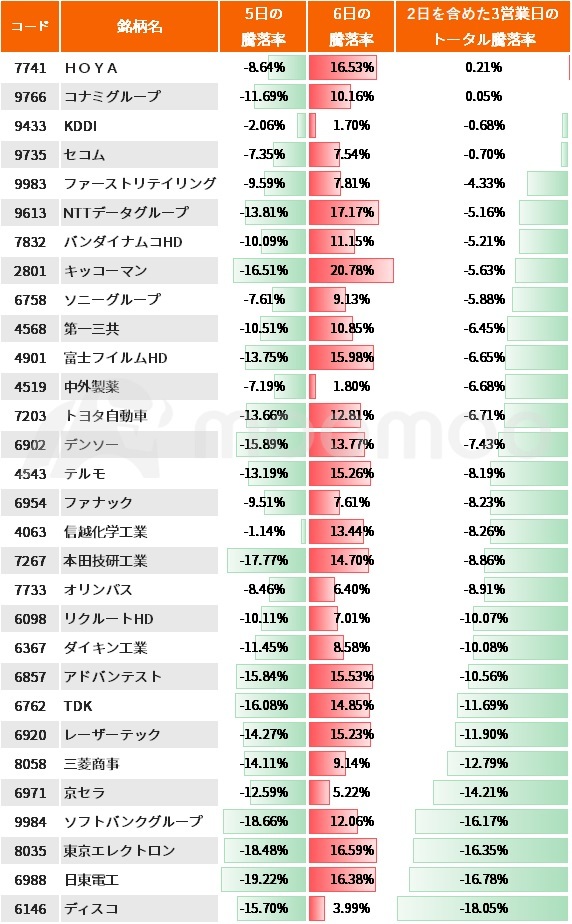Is it a "great buying opportunity" or the beginning of a bear market? After a huge crash, the Nikkei Average had its largest increase ever!
On the 6th, the Japanese stock market, following the historic decline on the 5th, rebounded significantly, with the Nikkei average up 10.23% and TOPIX up 9.30%.The Nikkei average, turning around from the previous day's record decline of 4,451.28 yen, recorded the largest increase of 3,217.04 yen.In addition to the rebound from the decline on the 5th, the reversal of the exchange rate to a weaker yen, and the market's relief as the US July ISM non-manufacturing PMI exceeded market expectations at 51.4, easing concerns of an economic slowdown.
Regarding the volatile movement of the Japanese stock market, domestic fund managers believe that "overseas long-term investors see it as a bargain sale and are moving to buy".There is a possibility that "overseas long-term investors see it as a bargain sale and are moving to buy" (Nikkei newspaper dated 6th).Furthermore, Bloomberg dated 6th states that "as the exchange rate stabilizes, buying back of Japanese stocks is occurring according to Risona Asset Management's Chief Strategist Shimode Shuuichi".If there is no change in performance, it is clear that Japanese stocks are undervalued.It introduces comments that some investors consider it a great buying opportunity.
On the other hand, Chief Strategist Shimode has also mentioned that it is likely to be a market driven by speculation due to a period with few economic indicators.Chief Market Strategist Masahiro Ichikawa of Sumitomo Mitsui DS Asset Management also expressed the view in the Sankei newspaper dated the 6th that the market is expected to show unstable movements for a while.For a while, the market is expected to show unstable movements.For a while, the market is expected to show unstable movements.Chief Market Strategist Masahiro Ichikawa of Sumitomo Mitsui DS Asset Management also expressed the view in the Sankei newspaper dated the 6th that the market is expected to show unstable movements for a while.
Citi Index's senior market strategist Matt Simpson described the movement of Japanese stocks as a "healthy adjustment after an unhealthy crash," and indicated the possibility of continued cautious investor sentiment.Not a rise in risk-on sentiment.(Bloomberg on the 6th) and analysis, suggesting the potential for continued cautious investor sentiment.
Looking at the movements of individual stocks over the 3 business days starting from the clear decline of the Nikkei Average and TOPIX on the 2nd of this month, the movements vary depending on the individual stocks. When totaling the movements of the 3 business days, there are stocks that recovered into a positive territory, such as etc. $Hoya (7741.JP)$や $Konami Group (9766.JP)$stocks and stocks that returned to their limit-up on the 6th. $Kikkoman (2801.JP)$There are also stocks such as etc. $Kyocera (6971.JP)$や $Disco (6146.JP)$、 $Tokyo Electron (8035.JP)$There are also stocks that have remained significantly depressed, such as etc.

By the way, on Black Monday in October 1987, when the daily decline rate of the Nikkei average was 14.9% and more severe than the big crash on the 5th, it took about 2 weeks for the stock prices to reach the bottom from the big crash on October 20th. The stock prices returned to the same level as the high on October 14th, just before Black Monday, in April of the following year, taking about 6 months.

moomoo news of individual stocks Kathy, Mark
Source: Nikkei, Sankei News, Bloomberg, moomoo
Source: Nikkei, Sankei News, Bloomberg, moomoo
Disclaimer: Moomoo Technologies Inc. is providing this content for information and educational use only.
Read more
Comment
Sign in to post a comment

モルガンの手先 : Investors are also on summer vacation this month, so it probably won't rise that much until around the 20th. It has been reversed starting from 8/20 every year. If American interest rate cuts are within a few months, I don't think it will take long for Nikkei to recover to 40000
エリックカートマン モルガンの手先 :![undefined [undefined]](https://static.moomoo.com/nnq/emoji/static/image/default/default-black.png?imageMogr2/thumbnail/36x36)
スマイリー山川 : Nikkei will not rise unless the yen depreciation buff is applied
It's impossible to go to 40000 unless the Bank of Japan and the government make a hawkish apology and don't cut interest rates
There are various stock markets in the world
The yen just appreciated, and I think I should buy that one